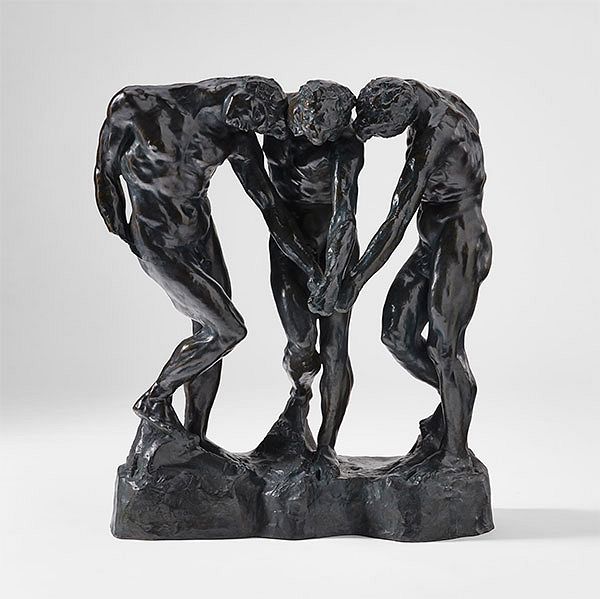Auguste Rodin, Trois ombres, Taille de la Porte dite aussi 'Moyen Modèle' — variante, 1981-82. 20th Century & Contemporary Art Day Sale - Morning Session.
Classical forms and more contemporary interpretations meet in Phillips 18 November 20th Century & Contemporary Art Day Sales. Here, we pair five Modern bronzes by Auguste Rodin, Aristide Maillol, and Henry Moore coming from an Important Private Japanese Collection with contemporary works that offer striking examples of balance, counterpoint, and interplay.
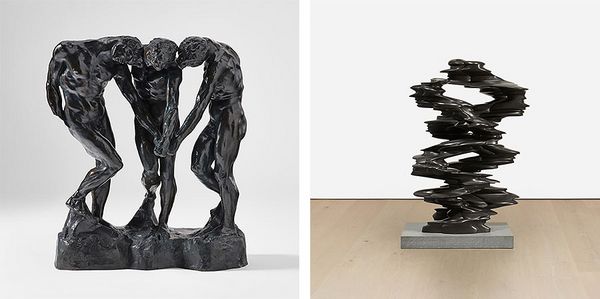
Left: Auguste Rodin, Trois ombres, Taille de la Porte dite aussi 'Moyen Modèle' — variante, 1981-82. 20th Century & Contemporary Art Day Sale - Morning Session. Right: Tony Cragg, Runner, 2011. 20th Century & Contemporary Art Day Sale - Afternoon Session.
Pairing 1: Auguste Rodin & Tony Cragg — Pushing Onward
Trois ombres depicts three identical male figures radiating from a single point where their left arms converge. Originating as three separate casts, the repeated figure likely evolved from an early study of Adam, which drew from Michelangelo’s Study for a Pietà in its bodily composition and hyper-defined flesh. The present work is an enlarged version of the three identical casts crowning the lintel of The Gates of Hell, looming above the scenes from Dante’s Inferno. In Inferno, the shades (ombres, or souls of the damned) stand at the entrance to Hell, pointing to the disconsolate inscription: “Abandon hope, all ye who enter here.” Dante wrote, “They all three made of themselves a wheel.” Thus, Rodin’s figures represented three recently dead souls, looking down in terror at the tormented melee into which they were about to be thrown.
"Runner," Tony Cragg said, "gives me that feeling that you get at the moment when you think that you know where you are going but you suspect that you may be running in the wrong direction." The shared physicality of movement along an axis, whether through the spiraling double helix or the meeting point of the figures' hands, opens each piece into deeper emotional landscapes, with themes of repetition, points of no return and, crucially, persistence. Runner then offers an unexpected complement to Trois ombres through its dervish-like quality, as its kinetic energy increases through upward movement, while the ombres cast a downward thrust into their fates.
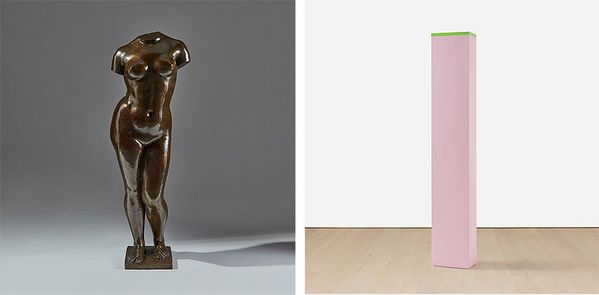
Left: Aristide Maillol, Torse de l'Eté, circa 1972-75. 20th Century & Contemporary Art Day Sale - Morning Session. Right: Anne Truitt, Spring Dryad, 1975. 20th Century & Contemporary Art Day Sale - Morning Session.
Pairing 2: Aristide Maillol & Anne Truitt — Rites of Spring
A contemporary of Rodin, Aristede Maillol shifted away from the despaired subjects and contorted figures of Rodin, gradually moving toward a more archetypical form of sculpture, epitomized in Torse de l’Eté. Maillol's practice sought to preserve and purify the classical sculptural tradition of the body, allowing for the work's physical presence to take precedent. The "Torso of Summer" is a robust representation of the season, carrying volume in its life-size scale, and displaying a languid posture with an extended hip as if bearing with break in a humid day.
Anne Truitt's Spring Dryad similarly departs from its conceptual milieu in favor of expressing meaning through its visual language of color and sensation. The sculpture modernizes the form through a radiant pink pillar topped by a thin band of green, embodying the gentle beauty of its associated season. The word dryad refers to a female figure in Greek mythology who inhabits a concentrated form of nature, typically a tree, and appearing in art and literature as a type of semi-human allegory or spirit that is difficult to grasp. Beyond the seasonal inspiration, both pieces share a common potentiality of movement through time and place — where Torse de l’Eté resonates with a corporeal freedom, Spring Dryad presents that same essence in its embryonic form; that of lightness discovering its full capacity.
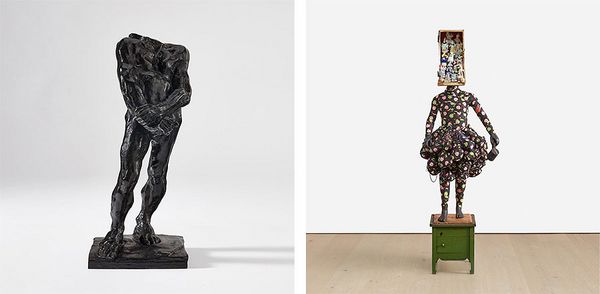
Left: Auguste Rodin, Balzac, étude de nu type F dite aussi 'étude en athlète', 1971. 20th Century & Contemporary Art Day Sale - Morning Session. Right: Vanessa German, a stunning rebuke to the manufacture of your benevolence by the fat negro sculpturess v.german upon the rape of her bountiful wholeness., 2016. 20th Century & Contemporary Art Day Sale - Afternoon Session.
Pairing 3: Auguste Rodin & vanessa german — A Call to Action
A voracious reader, Rodin intensely studied Honoré de Balzac’s literature in an attempt to capture the essence of the work’s source, ultimately to achieve a symbolic representation in bronze. His interest in exploring and capturing individual and human characteristics in his mythological, allegorical, and veridical subject matters — as the staunch form of the Balzac poignantly captures — achieves the human experience and psychological state of the figure. The significant gesture of the present work, its arms in a crossed and clasped pose, is just as expressive as any facial tell.
Compare the pose to the defiant openness of vanessa german's figure. The deeply internal nature of Balzac is countered by a public-facing antithesis in a highly embellished form. The psychology present in both pieces offers a glimpse at the options often presented to any protagonist: retreat or confrontration, the self or the community, the inward gaze or the outward pressure placed upon the shoulders. Does one then lose their head? Or do they fight against supposition?
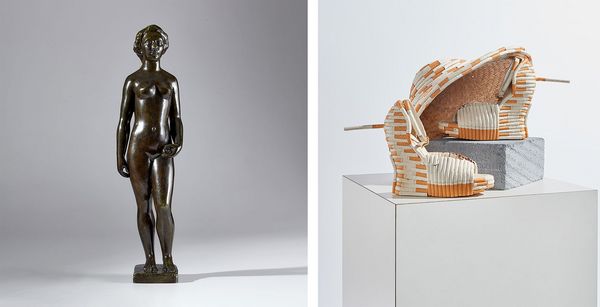
Left: Aristide Maillol, Petite Flore nue, circa 1952. 20th Century & Contemporary Art Day Sale - Morning Session. Right: Sarah Lucas, News of the World, 2006. 20th Century & Contemporary Art Day Sale - Afternoon Session.
Pairing 4: Aristide Maillol & Sarah Lucas — The Female Image
Maillol's appreciation for the classical form belies the modernity that comes across in his practice. Petite Flore nue, while a tribute to Flora, the Roman goddess of spring and flowers, found her head in the inspiration of a young girl Maillol saw walking down the street, and whom he quickly modeled in clay for the eventual sculpture. The work showcases what critic John Rewald calls a "peculiar balance between a firmness of forms which appear eternal and a sensitivity of expression — even sensuousness — which seems forever quivering and alive,” demonstrating elegance at its most unadorned.
Consider then what Sarah Lucas' News of the World transposes upon the feminine symbols of wedge sandals and a sunhat. Recall the "Torches of Freedom" campaign — the co-opting of first-wave feminism to tie cigarette smoking to notions of freedom and liberation by by Ed Bernays and the advertising world — and the notions of the male gaze, women as consumable subjects, and the specter of purity come into a new light. The two pieces together present a spectrum of identity, both as imagined and as projected.
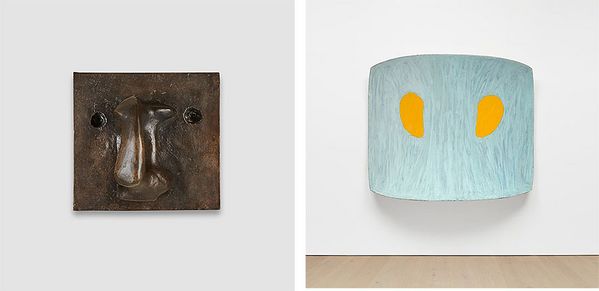
Left: Henry Moore, Square Head Relief, 1962-63. 20th Century & Contemporary Art Day Sale - Morning Session. Right: Ron Gorchov, Comedy, 1975. 20th Century & Contemporary Art Day Sale - Morning Session.
Pairing 5: Henry Moore & Ron Gorchov — Metafiction
While Henry Moore’s exploration of the emotional interiority of humanity and his interest in culling from literature shares an affinity with Rodin’s central concerns, Moore’s work formally coincides with Maillol’s softened edges and placid presence.Square Head Relief demonstrates Moore's distinctive reduction of the human figure to its most essential elements, which he then abstracts as an expession of the human state. The result is almost canvas-like with a squared field giving way to a three-dimensional focus point that can be observed and interpreted from multiple angles, much like the metafiction texts which were emerging concurrently in the world of literature.
Gorchov's approach finds its dimension through the bending and shaping of the canvas itself. Comedy rests upon a concave shield of blue and merging the forms of sculpture and painting. The twin dashes of mustard-yellow countenance a dialogue, almost as quotations, lending an element of conversation to any piece that might hang beside it, open to any possibile configuration — not unlike William Gaddis' J R, a piece written almost entirely in dialogue, or Square Head Relief, which stares back through hollow eyes.
Discover More from 20th Century & Contemporary Art >
Global Gallery Tour 20th Century & Contemporary Art
Join us on a virtual global gallery tour of Phillips’ upcoming 20th Century and Contemporary Art auction being held in our brand new, state-of-the-art gallery at 432 Park Avenue in the heart of New York City.
Recommended Reading
